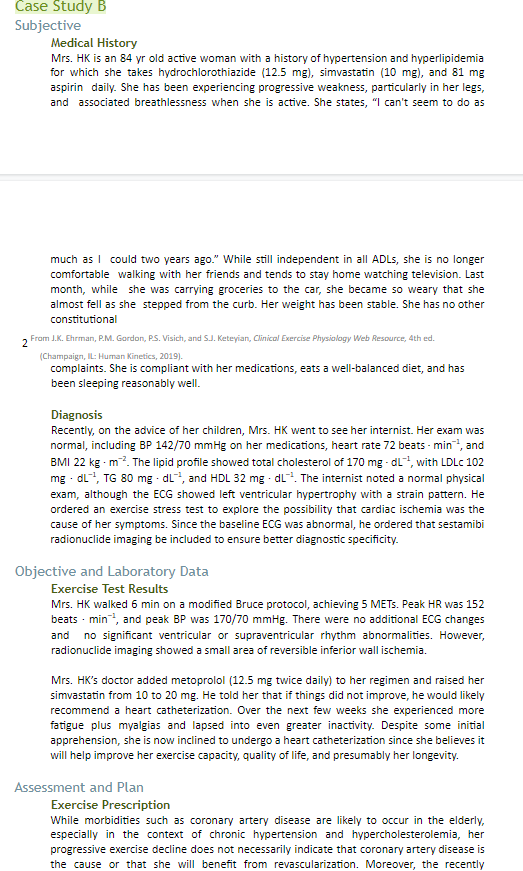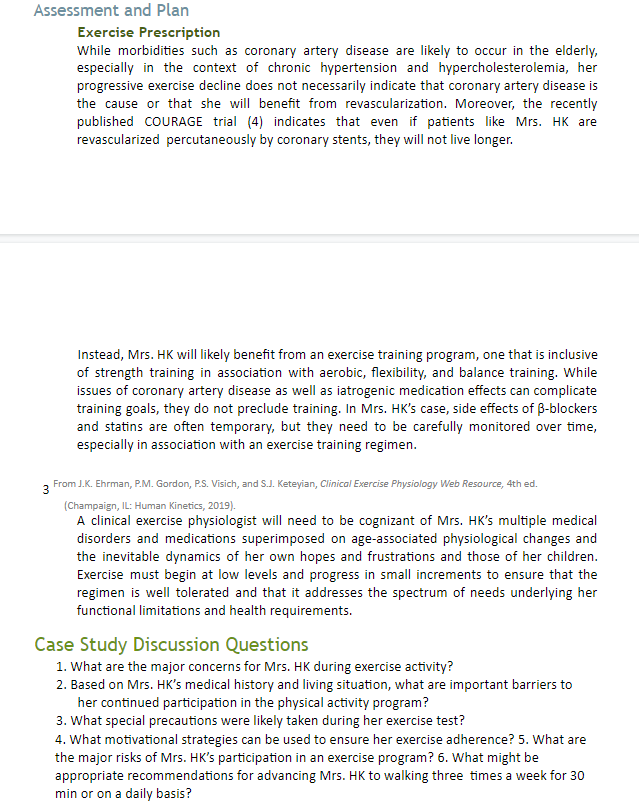1. What are the major concerns for Mrs. HK during exercise activity? 2. Based on Mrs. HK's medical history and living situation, what are important barriers to her continued participation in the physical activity program? 3. What special precautions were likely taken during her exercise test?
1. What are the major concerns for Mrs. HK during exercise activity? 2. Based on Mrs. HK's medical history and living situation, what are important barriers to her continued participation in the physical activity program? 3. What special precautions were likely taken during her exercise test?
Surgical Tech For Surgical Tech Pos Care
5th Edition
ISBN:9781337648868
Author:Association
Publisher:Association
Chapter7: Preventing Perioperative Disease Transmission
Section: Chapter Questions
Problem 7.2.4CS
Related questions
Question
questions 1-6

Transcribed Image Text:Čase Study B
Subjective
Medical History
Mrs. HK is an 84 yr old active woman with a history of hypertension and hyperlipidemia
for which she takes hydrochlorothiazide (12.5 mg), simvastatin (10 mg), and 81 mg
aspirin daily. She has been experiencing progressive weakness, particularly in her legs,
and associated breathlessness when she is active. She states, "I can't seem to do as
much as I could two years ago." While still independent in all ADLS, she is no longer
comfortable walking with her friends and tends to stay home watching television. Last
month, while she was carrying groceries to the car, she became so weary that she
almost fell as she stepped from the curb. Her weight has been stable. She has no other
constitutional
2 From J.K. Ehrman, P.M. Gordon, PS. Visich, and SJ. Keteyian, Clinical Exercise Physiolagy Web Resource, 4th ed.
(Champaign, IL: Human Kinetics, 2019).
complaints. She is compliant with her medications, eats a well-balanced diet, and has
been sleeping reasonably well.
Diagnosis
Recently, on the advice of her children, Mrs. HK went to see her internist. Her exam was
normal, including BP 142/70 mmHg on her medications, heart rate 72 beats - min, and
BMI 22 kg - m?. The lipid profile showed total cholesterol of 170 mg - dL, with LDLC 102
mg - dl, TG 80 mg - dL, and HDL 32 mg - dL. The internist noted a normal physical
exam, although the ECG showed left ventricular hypertrophy with a strain pattern. He
ordered an exercise stress test to explore the possibility that cardiac ischemia was the
cause of her symptoms. Since the baseline ECG was abnormal, he ordered that sestamibi
radionuclide imaging be included to ensure better diagnostic specificity.
Objective and Laboratory Data
Exercise Test Results
Mrs. HK walked 6 min on a modified Bruce protocol, achieving 5 METS. Peak HR was 152
beats - min, and peak BP was 170/70 mmHg. There were no additional ECG changes
and no significant ventricular or supraventricular rhythm abnormalities. However,
radionuclide imaging showed a small area of reversible inferior wall ischemia.
Mrs. HK's doctor added metoprolol (12.5 mg twice daily) to her regimen and raised her
simvastatin from 10 to 20 mg. He told her that if things did not improve, he would likely
recommend a heart catheterization. Over the next few weeks she experienced more
fatigue plus myalgias and lapsed into even greater inactivity. Despite some initial
apprehension, she is now inclined to undergo a heart catheterization since she believes it
will help improve her exercise capacity, quality of life, and presumably her longevity.
Assessment and Plan
Exercise Prescription
While morbidities such as coronary artery disease are likely to occur in the elderly,
especially in the context of chronic hypertension and hypercholesterolemia, her
progressive exercise decline does not necessarily indicate that coronary artery disease is
the cause or that she will benefit from revascularization. Moreover, the recently

Transcribed Image Text:Assessment and Plan
Exercise Prescription
While morbidities such as coronary artery disease are likely to occur in the elderly,
especially in the context of chronic hypertension and hypercholesterolemia, her
progressive exercise decline does not necessarily indicate that coronary artery disease is
the cause or that she will benefit from revascularization. Moreover, the recently
published COURAGE trial (4) indicates that even if patients like Mrs. HK are
revascularized percutaneously by coronary stents, they will not live longer.
Instead, Mrs. HK will likely benefit from an exercise training program, one that is inclusive
of strength training in association with aerobic, flexibility, and balance training. While
issues of coronary artery disease as well as iatrogenic medication effects can complicate
training goals, they do not preclude training. In Mrs. HK's case, side effects of B-blockers
and statins are often temporary, but they need to be carefully monitored over time,
especially in association with an exercise training regimen.
3 From J.K. Ehrman, P.M. Gordon, P.S. Visich, and S.J. Keteyian, Clinical Exercise Physiology Web Resource, 4th ed.
(Champaign, IL: Human Kinetics, 2019).
A clinical exercise physiologist will need to be cognizant of Mrs. HK's multiple medical
disorders and medications superimposed on age-associated physiological changes and
the inevitable dynamics of her own hopes and frustrations and those of her children.
Exercise must begin at low levels and progress in small increments to ensure that the
regimen is well tolerated and that it addresses the spectrum of needs underlying her
functional limitations and health requirements.
Case Study Discussion Questions
1. What are the major concerns for Mrs. HK during exercise activity?
2. Based on Mrs. HK's medical history and living situation, what are important barriers to
her continued participation in the physical activity program?
3. What special precautions were likely taken during her exercise test?
4. What motivational strategies can be used to ensure her exercise adherence? 5. What are
the major risks of Mrs. HK's participation in an exercise program? 6. What might be
appropriate recommendations for advancing Mrs. HK to walking three times a week for 30
min or on a daily basis?
Expert Solution
This question has been solved!
Explore an expertly crafted, step-by-step solution for a thorough understanding of key concepts.
This is a popular solution!
Trending now
This is a popular solution!
Step by step
Solved in 2 steps

Knowledge Booster
Learn more about
Need a deep-dive on the concept behind this application? Look no further. Learn more about this topic, nursing and related others by exploring similar questions and additional content below.Recommended textbooks for you

Surgical Tech For Surgical Tech Pos Care
Health & Nutrition
ISBN:
9781337648868
Author:
Association
Publisher:
Cengage

Essentials of Pharmacology for Health Professions
Nursing
ISBN:
9781305441620
Author:
WOODROW
Publisher:
Cengage

Surgical Tech For Surgical Tech Pos Care
Health & Nutrition
ISBN:
9781337648868
Author:
Association
Publisher:
Cengage

Essentials of Pharmacology for Health Professions
Nursing
ISBN:
9781305441620
Author:
WOODROW
Publisher:
Cengage